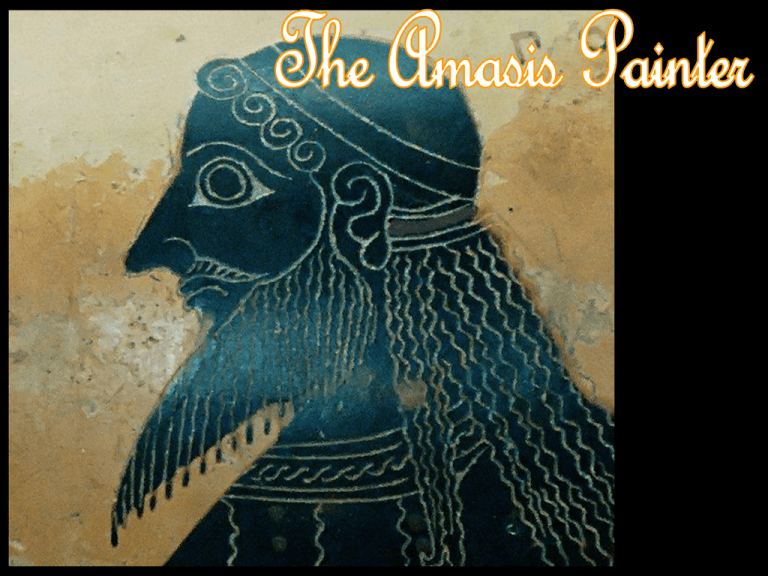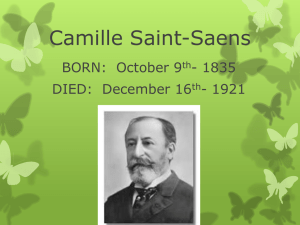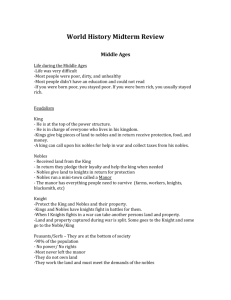The Amasis Painter Date
advertisement

Background -The Amasis Painter was a famous artisan with a unique style -It is highly probable that this Egyptian artist both painted and potted his vases. -It is also thought that he was named after an Egyptian Pharaoh called Ahmosis as he often signed his vases with “Amasis made me” -He made 102 items approximately 12 were signed and 90 unsigned these included Amphorae, a Pyxis , four Olpe, two cups and a small bowl. Continued … -He was a major black figure artist who primarily gained inspiration from Greece's mythical and legendary past. -He painted possibly with the function of the vessel in mind when he painted Dionysus his Satyrs and the Maenads which he depicted with great regularity (the Amphora would have been used for mixing wine, hence the reference to Dionysus). -He painted the comical antics of Dionysus’s satyrs who were long land and shaggy looking. To decorate them he used raised relief dots to depict their hair and beards. -Later, he introduced another innovation for painting the flesh of maenads and other women. -Typically painter used a black glaze first and applied white slip over the top however Amasis preferred to paint the female character in outline and then paint in the white on the reserved surface of the clay which was practiced later in the red figure technique. -The Amasis Painter was first to focus on aspects of everyday life. These included a marriage procession, women weaving and spinning wool and a hunter returning home, his vases in these domestic scenes rarely depicted gods. -The Lekythoi were unique also for the insight they gave the viewer into the secret world of Athenian women and it provides the historical evidence to be able to know aspects of Athenians day to day life. Basic Facts … Potter – The Amasis Painter Date- c560-550BC Height – 17 centimetres - In this Vase The Amasis Painter depicts the earliest archaic representation of women weaving. -The women are presented in profile and the poses vary with each different activity the women are carrying out. - He attempts to indicate depth by placing women in front of a large standing loom which appears to be further away. -through placing the women in groups of two at approximately equal distance he creates a rhythmic composition. -The Vase reads from right to left beginning with a single woman standing , directing the other women with hand gestures. -A woman stands in-front of her who is lifting bundles of wool out of a basket and placing them on a large pair of scales which is held by another female companion. -The central focus of the vase is two women who stand upright by the loom weaving. One pushes the shuttle across the loom, The other beats the wool fibre up into position. -To the left of the loom stand a second pair of women, on unravels the wool into a basket to prepare it for spinning, the other spins it with a hanging spindle. -two women fold and embroidered cloth between them, a folded pile of cloth sits in front of them on a low stool. -The narrative concludes with two women unravelling bundles of wool, one stands whilst the other is seated. -Each of the women on the vase wears an embroidered peplos (dress), onto which the Amasis painter has used the technique incision to create the embroidered decoration. - There is a second miniature frieze separated from the first central scene by a band of mirrored diamonds depicted. Which depicts a woman seated between two standing youth. Two additional younger men approach this group on either side behind each of the youth. The two woman dance together hand in hand. -The meaning of this second frieze is unsure , it could be assumed that the seated woman is a bride as she holds a similar looking band to the bride of the Amaisis Painters second Lekythoi, the wedding procession. -The wedding band may represent the ritual crown worn by a newly wedded woman. Information… -The scene is a study of every day life in archaic Greece, a wedding procession. -All of the figures are presented in profile however the Amasis painter has varried their poses to create a sense of movement which enlivens the composition. -He is attempted to portray depth by placing one figure behind another e.g. women walking behind the mules. -The continuous narrative is read from left to right -The torch held by a woman, who may be the bridegrooms mother, reminds viewers that the procession usually occurred at night. -A single woman carries two torches and led the procession -Behind her are two carriages escorted by two women and a man which carries the bridal couple and a third male passenger. -The second carriage carries four members of the bridal party which are relatives of the bride accompanying the women to her new home. Techniques -He has added a lot of white in his composition, mostly for the flesh of women but also for the body of both carriages and the muzzles of the mules. -The circular object held by the bride has been identified as the ritual crown worn by newly wedded women. -All the women in the composition wear an embroidered peplos while the men wear a long chiton and a himation. -The artist has gone for the exterior detail of the clothing rather than attempting to give it depth. - on the miniature freize on the shoulder band of the lekythos two men play musical instruments to entertain nine young girls who dance stiffly in a single file around the vase. -The scene in the miniature frieze was supposed to represent a part of the wedding festivities, perhaps a wedding dance.















